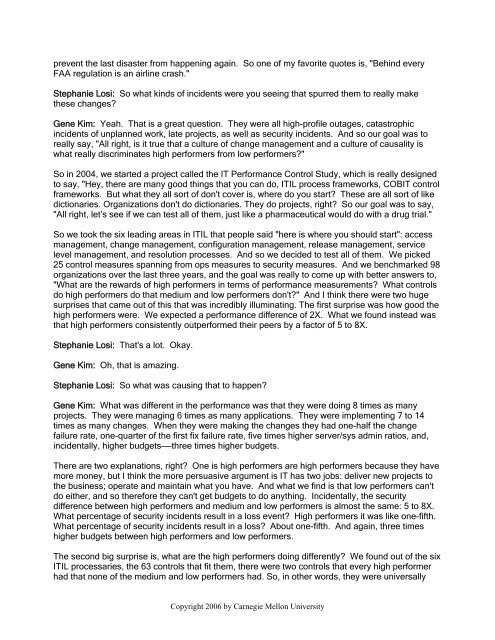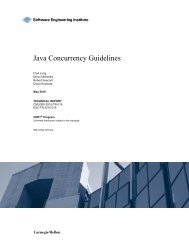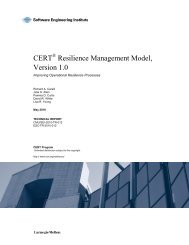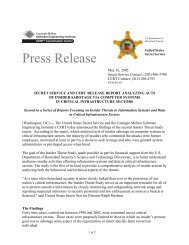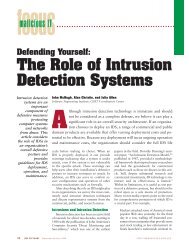The Security 'X' Factor Transcript Part 1: The Study Stephanie ... - Cert
The Security 'X' Factor Transcript Part 1: The Study Stephanie ... - Cert
The Security 'X' Factor Transcript Part 1: The Study Stephanie ... - Cert
Create successful ePaper yourself
Turn your PDF publications into a flip-book with our unique Google optimized e-Paper software.
prevent the last disaster from happening again. So one of my favorite quotes is, "Behind every<br />
FAA regulation is an airline crash."<br />
<strong>Stephanie</strong> Losi: So what kinds of incidents were you seeing that spurred them to really make<br />
these changes?<br />
Gene Kim: Yeah. That is a great question. <strong>The</strong>y were all high-profile outages, catastrophic<br />
incidents of unplanned work, late projects, as well as security incidents. And so our goal was to<br />
really say, "All right, is it true that a culture of change management and a culture of causality is<br />
what really discriminates high performers from low performers?"<br />
So in 2004, we started a project called the IT Performance Control <strong>Study</strong>, which is really designed<br />
to say, "Hey, there are many good things that you can do, ITIL process frameworks, COBIT control<br />
frameworks. But what they all sort of don't cover is, where do you start? <strong>The</strong>se are all sort of like<br />
dictionaries. Organizations don't do dictionaries. <strong>The</strong>y do projects, right? So our goal was to say,<br />
"All right, let’s see if we can test all of them, just like a pharmaceutical would do with a drug trial."<br />
So we took the six leading areas in ITIL that people said "here is where you should start": access<br />
management, change management, configuration management, release management, service<br />
level management, and resolution processes. And so we decided to test all of them. We picked<br />
25 control measures spanning from ops measures to security measures. And we benchmarked 98<br />
organizations over the last three years, and the goal was really to come up with better answers to,<br />
"What are the rewards of high performers in terms of performance measurements? What controls<br />
do high performers do that medium and low performers don't?" And I think there were two huge<br />
surprises that came out of this that was incredibly illuminating. <strong>The</strong> first surprise was how good the<br />
high performers were. We expected a performance difference of 2X. What we found instead was<br />
that high performers consistently outperformed their peers by a factor of 5 to 8X.<br />
<strong>Stephanie</strong> Losi: That's a lot. Okay.<br />
Gene Kim: Oh, that is amazing.<br />
<strong>Stephanie</strong> Losi: So what was causing that to happen?<br />
Gene Kim: What was different in the performance was that they were doing 8 times as many<br />
projects. <strong>The</strong>y were managing 6 times as many applications. <strong>The</strong>y were implementing 7 to 14<br />
times as many changes. When they were making the changes they had one-half the change<br />
failure rate, one-quarter of the first fix failure rate, five times higher server/sys admin ratios, and,<br />
incidentally, higher budgets——three times higher budgets.<br />
<strong>The</strong>re are two explanations, right? One is high performers are high performers because they have<br />
more money, but I think the more persuasive argument is IT has two jobs: deliver new projects to<br />
the business; operate and maintain what you have. And what we find is that low performers can't<br />
do either, and so therefore they can't get budgets to do anything. Incidentally, the security<br />
difference between high performers and medium and low performers is almost the same: 5 to 8X.<br />
What percentage of security incidents result in a loss event? High performers it was like one-fifth.<br />
What percentage of security incidents result in a loss? About one-fifth. And again, three times<br />
higher budgets between high performers and low performers.<br />
<strong>The</strong> second big surprise is, what are the high performers doing differently? We found out of the six<br />
ITIL processaries, the 63 controls that fit them, there were two controls that every high performer<br />
had that none of the medium and low performers had. So, in other words, they were universally<br />
Copyright 2006 by Carnegie Mellon University


